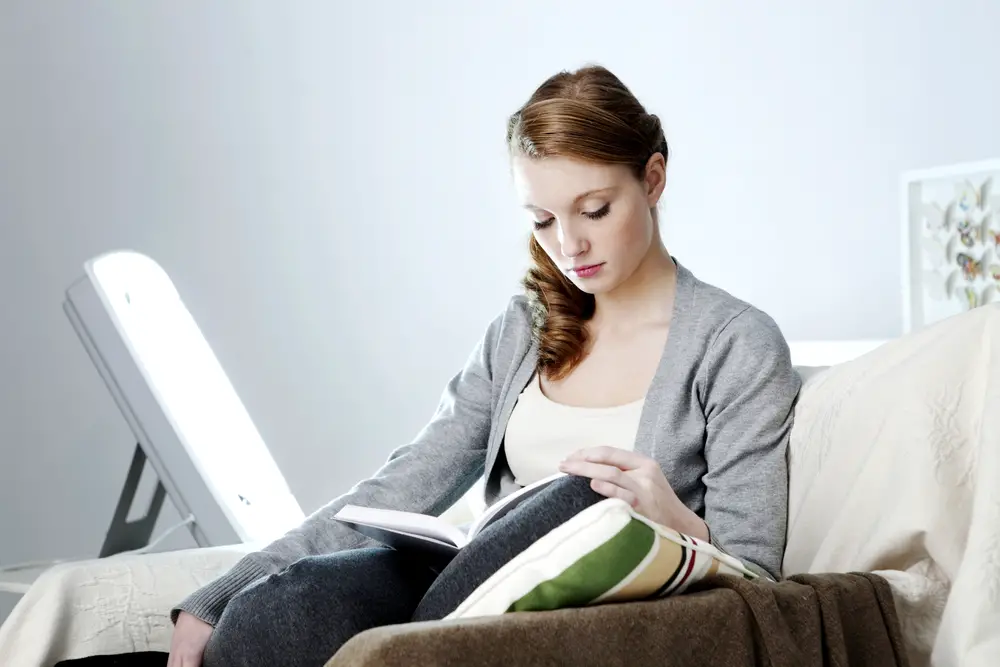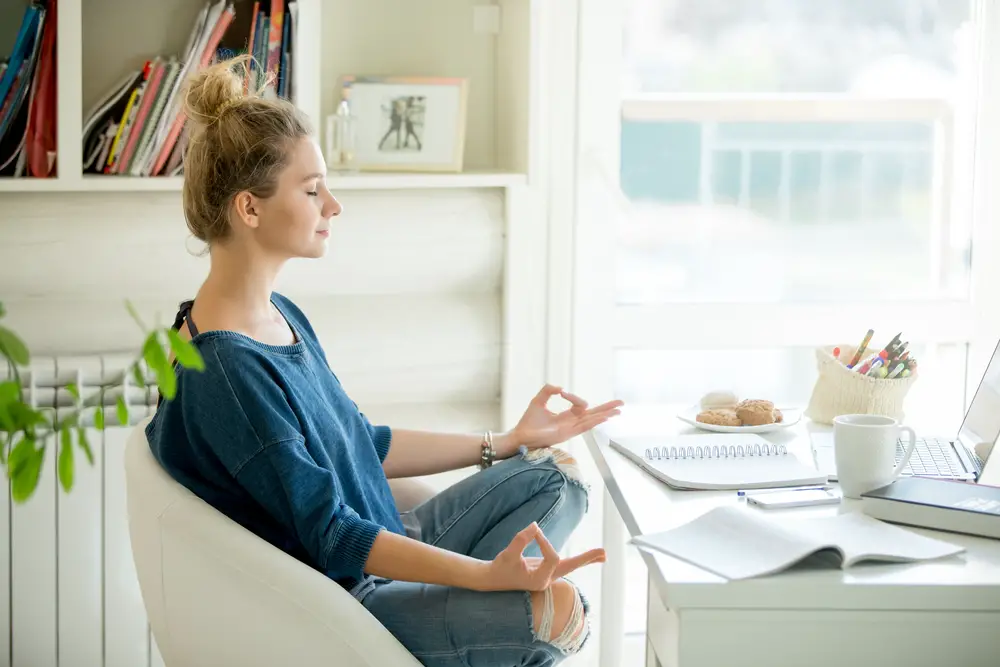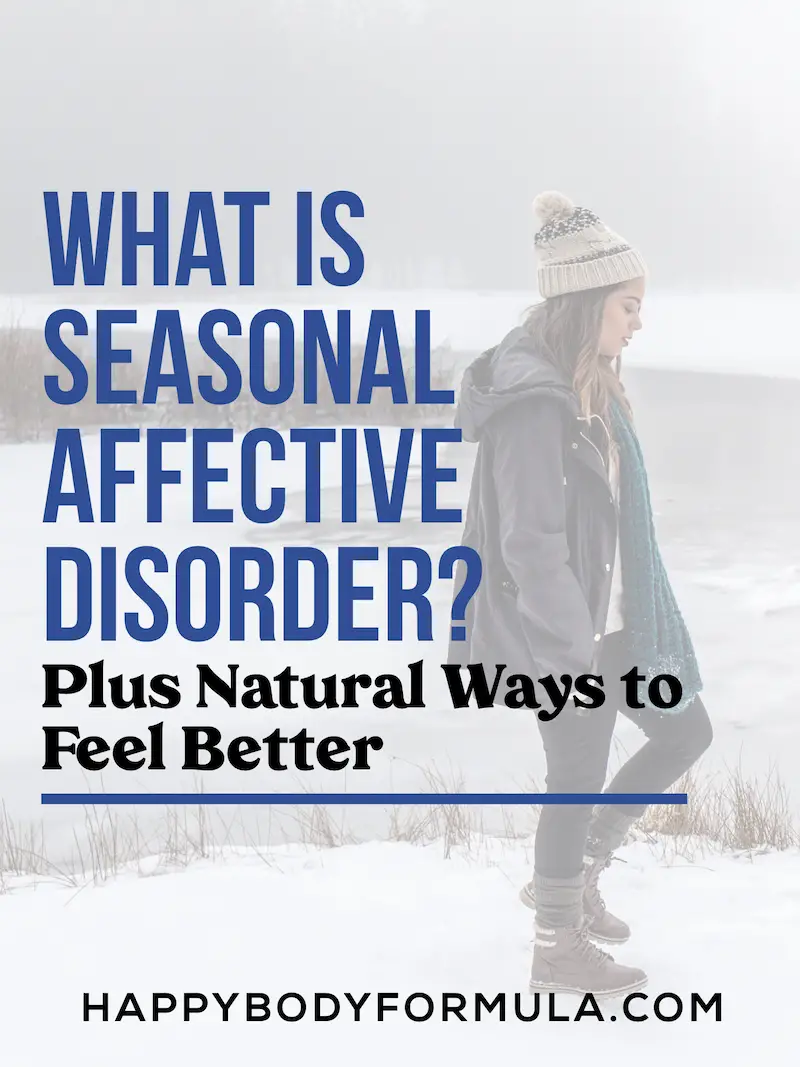Seasonal affective disorder is often used to describe feelings of winter blues or sadness, but it’s an actual medical disorder.
If you get sad during the winter months or on gray, cold days, you are not alone.
More than 10 million Americans experience signs of seasonal affective disorder, with as many as 20 percent of adults or adolescents having signs of it in one way or another.
[toc]
What is Seasonal Affective Disorder (SAD)?
Seasonal Affective Disorder, or SAD as it is commonly known, refers to a certain type of depression that is related to or triggered by the change in seasons. It often occurs cyclically, at the same time each year.
While most cases of seasonal affective disorder happen in the fall heading into the winter, it can occur in any season where there could be a trigger or trauma that caused it.
SAD is often caused by fall and winter weather since it is also associated with depression associated with more gray days and bad weather and an inability to access bright sunshine and warm weather.
Seasonal affective disorder can exist on its own or can occur with other types of depression or mental health conditions like major depressive disorder, postpartum depression, or post-traumatic stress disorder.
What Causes Seasonal Affective Disorder (SAD)?
Seasonal affective disorder doesn’t have a single known cause. In many cases, several factors could be present and contributing factors can be different from one person to the next.
Contributing factors to the cause of seasonal affective disorder can include:
- Living in parts of the country or world that have shorter days and longer nights in the colder months (like northern parts of North America or Europe)
- Having a job that decreases daytime exposures to natural sunlight, like working third shift
- Having lower levels of serotonin or other neurotransmitters
- Experiencing extreme stress or trauma
- Having a traumatic experience during the time of year when SAD typically begins
Risk factors that might increase your chances of developing seasonal affective disorder include:
- Being a woman
- Being under age 50
- Being related to anyone who has experienced any type of depression or other psychological disorder
- Having any existing condition associated with depression, bipolar disorder, or other mental health diagnosis
- Having any type of hormone or chronic health disorder
- Having inflammation problems
Signs and Symptoms of Seasonal Affective Disorder
Seasonal affective disorder is more than just feeling down for a few days or a few weeks. It tends to set in during the late weeks of fall and dissipates as the sunny days of spring arrive. Symptoms tend to start mild and increase as the season goes on.
Common symptoms of seasonal affective disorder include:
- Fatigue during the day
- Constantly feeling tired or always feeling the need for a nap
- Sleeping but not feeling rested
- Having problems concentrating
- Feeling hopeless or down
- Experiencing irritation and mood changes
- Having lessened or no interest in social activities or interaction
- Reduced sexual drive or desire
- Feeling generally unhappy
- Gaining weight
- Food cravings for sweets or junk foods
- Feeling sad all the time
- Not laughing at things that are usually funny
- Feeling anxious
Experiencing one or more of these symptoms does not mean that you automatically have seasonal affective disorder. Other conditions can mimic the symptoms of SAD or you can have seasonal affective disorder alongside other conditions.
Conditions with overlapping symptoms of seasonal affective disorder include:
- Hypothyroidism or Hashimoto’s thyroiditis
- Postpartum depression
- Major depressive disorder
- Bipolar disorder
- Mononucleosis
- Chronic fatigue syndrome
If you have symptoms on this list, be sure to speak with your doctor about getting a proper diagnosis or ruling out other causes.
Treatment for and Natural Ways to Address Seasonal Affective Disorder
There are several different treatment approaches for seasonal affective disorder. Most people use a combination of options. There are conventional medical options, lifestyle changes, alternative methods, and more.
Common ways to address SAD include:
- Light therapy, also known as phototherapy
- Antidepressants
- Therapy
- Aromatherapy
- Exercise
- Healthy sleep habits
- Acupuncture
- Meditation
- Yoga
Most treatment plans for seasonal affective disorder are customized for the individual and the reasons that SAD is affecting the person. These are the most common ways that SAD might be addressed and why.
Light therapy

A great treatment for seasonal affective disorder, light therapy is free from side effects and is easy for anyone to try.
Because it is thought that seasonal affective disorder has roots in short days and long nights with lack of adequate exposure to sunlight, light therapy is thought to help correct some of the underlying chemical imbalance and feelings of depression.
While light therapy is not the same as lying on the beach under direct sunlight, the brain processes the light from specialized photo boxes in the same way that it does from the sun.
Light therapy can even be beneficial for people without seasonal affective disorder who simply cannot stand the long, dark days.
Any type of light won’t work for SAD treatment, however. Tanning beds, for example, will not help improve seasonal affective disorder. Make sure to get a doctor’s recommendation for a photo box for light therapy.
In general, you need to make sure that it has at least 10,000 lux exposure to be effective. Don’t stare directly into it, the same as you wouldn’t with the sun, but keep it around one to two feet away from you.
Simply have it around you while you are doing something else, like reading a book. You need to have the light around you for at least 30 minutes per day, but it can be done all at once or in different shorter sessions.
You can also be around it longer. Make sure your first exposure is before or by 9am, much like the morning sun, and don’t use it after 3pm. If light therapy causes headaches, discontinue use and work with your doctor to find the right solution.
How soon can you feel positive effects from light therapy?
Generally, you might start to feel better within a few days or a few weeks in more extreme cases. Some doctors will want you to start with just a few days per week, while others may ask you to start using it daily immediately.
As with anything, personalized information and advice from your healthcare provider is most important.
You can find many light therapy options online, but it’s important to make sure you purchase a light box that meets your doctor’s specifications and is high quality. Be sure you know the company’s return policy before you purchase.
Medications
Antidepressants are used to treat many kinds of depression or mental health disorders.
Certain types of antidepressants work to increase the neurotransmitter dopamine, while others work to increase serotonin by helping the brain to better use what it has and promoting the production of more.
People can have highly sensitive or individualized reactions to antidepressants and certain kinds may work better for one person than another.
Your doctor will be able to prescribe an antidepressant that seems best suited to your situation, however, it’s important that you communicate with your doctor how you’re feeling.
In some, antidepressants can worsen your feelings or symptoms and it could mean that you need another type or option. Do not assume that it’s normal to feel worse or that you should keep your feelings to yourself.
The type of antidepressant you need can depend on other health issues you have, too. If you’re pregnant or breastfeeding, for example, there are safe options but it’s important to communicate these details to your healthcare provider.
If you take other medications you may need to find an option that won’t interact with those.
If seasonal affective disorder happens for you on a yearly basis, your doctor may recommend pre-treating each season before your symptoms begin in the hopes of avoiding symptoms that gradually worsen.
Most antidepressants take a little time before they start to work. In most cases, it can take one or two weeks before you notice them.
Therapy or Counseling
Working with a therapist or counselor can help to address seasonal affective disorder or feelings of depression. Some therapists make use of cognitive behavioral therapy which can be effective against negative thoughts, depression, anxiety, stress, social avoidance, and more.
Whether you meet weekly, twice a month, or monthly, having regular therapy appointments can help to address underlying causes or associated stressors or triggers.
If you cannot physically get to a therapy session, many offer online or video therapy. You can even work with qualified therapists now via smartphone apps, so there’s no reason to be unable to use therapy as a mode of treatment.
Most insurance plans will contribute to or pay for therapy, or if you don’t have insurance that will contribute, most therapists work with a sliding scale that is income-based.
Meditation

If you’ve never done meditation before, it can be intimidating, especially if being alone with your thoughts feels like a scary or depressing thing.
Guided meditation can help calm an anxious or stressed mind and can help change the pattern of thoughts. It won’t simply leave you alone with thoughts that you’d rather not deal with, but will give you better ways to strengthen your mind and build positive thinking.
Yoga
More than just a type of exercise, yoga is great for mind-body and mental health because it helps to promote focus and calm that leads to lower levels of stress, anxiety, and depression.
You don’t have to be flexible or skilled at yoga to get benefits either. Try an at-home yoga workout guided by an app or YouTube video and you’ll get the same positive results as if you went to a class at the local gym or studio.
Twenty minutes of yoga three or four times a week is beneficial for mental health, and it can even be done before bed to promote better sleep.
How to Cope with Seasonal Affective Disorder
Utilizing light therapy, antidepressants, therapy, and other lifestyle changes can make coping with seasonal affective disorder a little easier.
In addition to these, other strategies can make it easier to cope and even transform moments from surviving into thriving.
Consider the following options to support your mental health through seasonal affective disorder:
- Taking walks outside. Even if it’s cold, gray, cloudy, or snowy, being in fresh air and being in touch with nature can still have positive effects on mental health.
- Open the drapes/blinds. Even if the sun isn’t shining, having a connection to the outside world can make your internal world feel less dreary or reclusive.
- Write positive mantras in places that you will see them. Whatever negative, anxious, or depressive thoughts tend to occupy your mind, write positive and affirming mantras that you will see throughout the day. Consider placing them on the refrigerator, at your desk, on your bathroom mirror, by your bedside, and even on your car dashboard. Replacing negative repeating thoughts with positive truths can help to erode at negativity, anxiety, and depression.
- Prioritize exercise, even if you don’t do it for a long amount of time. Usually it’s just getting started that’s hard, but even so, just aim to exercise for three to five minutes. If you want to stop after that, at least you’ve done something, but in most cases, you’ll feel more positive for having started and might want to continue.
- Keep your doctor and therapy appointments. Even when you know professionals can help you, the urge to cancel appointments when going through depression or SAD can be strong. Don’t cancel your appointments and, in fact, make extra ones if you think they could help you.
- Find at least a weekly reason to get out of the house for fun. Even if it’s a quick errand like running to get a cup of coffee, plan to leave the house for something positive and personal. If you work from home this is exponentially more important.
- Set a regular bedtime and don’t miss it. Leave your smartphone, computer, and TV in a different room so that you don’t spend your sleep time staring at devices. If you struggle with insomnia and cannot sleep, work with your doctor to find a healthy sleep aid.
- Learn healthy coping strategies for stress or panic attacks that will make it easier to bounce back. Deep breathing is often helpful, especially when paired with meditation. Use a smartphone app for guided meditation if you don’t know how to begin or have trouble focusing.
- Call a friend and make plans to do something even if you aren’t remotely interested in being social. Sometimes the simple act of getting out and focusing on someone or something else can help to change the pattern of thoughts or feelings.
Share on Pinterest

References
- Rosenthal NE, Sack DA, Gillin JC, et al. Seasonal affective disorder. A description of the syndrome and preliminary findings with light therapy. Arch Gen Psychiatry. 1984;41:72–80.
- Rosen L, Targum S, Terman M, et al. Prevalence of seasonal affective disorder at four latitudes. Psychiatry Res. 1990;31:131–44.
- Maes M, Neumeister A, Konstantinidis A, et al. Monoaminergic function in the pathogenesis of seasonal affective disorder. Int J Neuropsychopharmacol. 2001;4:409–20.
Aimee McNew, MNT, CNTP, is a certified nutritionist who specializes in women’s health, thyroid problems, infertility, and digestive wellness. She ate her way back to health using a Paleo diet, lost 80 pounds, and had a healthy baby after numerous miscarriages. She focuses on simple nutrition practices that promote long-lasting results.
